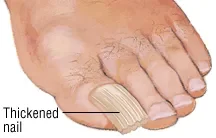
Thick toenails, also known as onychauxis, is a common condition that can affect people of all ages. It is usually caused by an overgrowth of the nail plate, which can make the nail appear thicker and more yellowed than normal. Some of the common causes of thick toenails include:
- Fungal Infection: This is the most common cause of thick toenails. Fungal infections, also known as onychomycosis, can cause the nails to become discoloured, thickened, and brittle.
- Trauma: If you have injured your toenail, it may grow back thicker than before. This is because the nail matrix, which is responsible for nail growth, may have been damaged during the injury.
- Aging: As you age, your toenails may grow more slowly and become thicker.
- Systemic Illness: Certain medical conditions, such as psoriasis, diabetes, and peripheral vascular disease, can cause thick toenails.
- Genetics: Some people may be more prone to developing thick toenails due to their genetic makeup.
Treatment for thick toenails depends on the underlying cause. If the cause is a fungal infection, anti-fungal medication may be prescribed to treat the infection. In some cases, oral medication or topical medication may be used. If the cause is trauma or injury, the nail may need to be removed or the underlying condition treated. In some cases, surgery may be required to correct the problem. It is important to consult with a healthcare professional if you are experiencing thick toenails, as they can help diagnose the underlying cause and recommend appropriate treatment.
